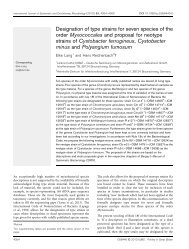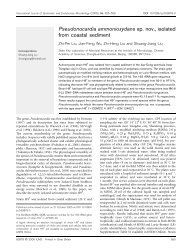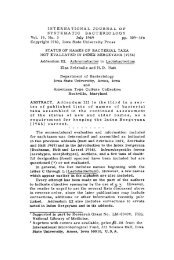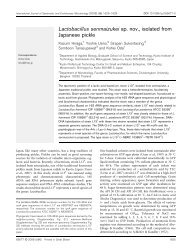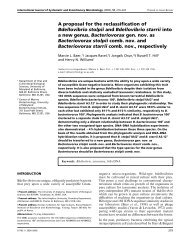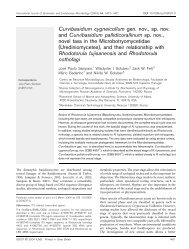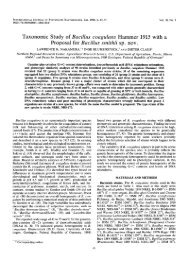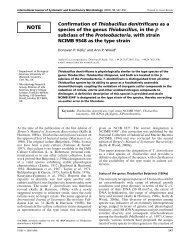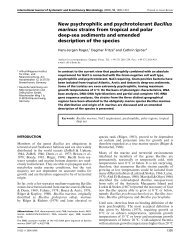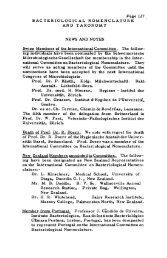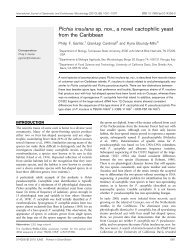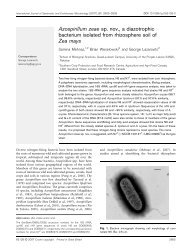Stenotrophomonas acidaminiphila sp. nov., a strictly aerobic ...
Stenotrophomonas acidaminiphila sp. nov., a strictly aerobic ...
Stenotrophomonas acidaminiphila sp. nov., a strictly aerobic ...
Create successful ePaper yourself
Turn your PDF publications into a flip-book with our unique Google optimized e-Paper software.
loss by freshly isolated strains of AMX 19T of the<br />
ability to use benzoate upon subculturing on solid<br />
media is not known, but similar results were observed<br />
previously for benzoate and hydrocarbons with S.<br />
maltophilia strains isolated from the soils of rice fields<br />
and oil fields (Garcia et al., 1981; Palleroni & Bradbury,<br />
1993). The carbonaceous substrates available to<br />
strain AMX 19T were, however, probably not restricted<br />
to those present in the wastewater. For instance,<br />
various organic compounds may be released during<br />
cell lysis and others, such as exopolymers, excreted by<br />
several organisms. These compounds include amino<br />
acids and peptides, which have been found as preferred<br />
substrates of strain AMX 19T. Moreover, in contrast<br />
to what happens with acetate, AMX 19T would not<br />
have to compete for them with methanogenic bacteria.<br />
Since strain AMX 19T was isolated from the environment,<br />
its impact on human health is not known, and<br />
it would be interesting to evaluate it, considering that<br />
some of its close relatives (S. maltophilia and S.<br />
africana) are recognized opportunistic pathogens. The<br />
preliminary information given by the antibiogram<br />
suggests, nevertheless, that it is sensitive to a large<br />
panel of antimicrobial agents presently available for<br />
therapeutics.<br />
Description of <strong>Stenotrophomonas</strong> <strong>acidaminiphila</strong> <strong>sp</strong>.<br />
<strong>nov</strong>.<br />
<strong>Stenotrophomonas</strong> <strong>acidaminiphila</strong> (a.ci.da.mi.ni.phila.<br />
N.L. acidum acid; N.L. n. aminum amine; N.L. fem.<br />
adj. phila from Gr. adj. philos loving; N.L. adj.<br />
<strong>acidaminiphila</strong> loving amino acids).<br />
Cells are straight to curved rods, 05 µm wide and<br />
15–25 µm long. Gram-negative, non-<strong>sp</strong>orulating,<br />
<strong>strictly</strong> <strong>aerobic</strong> bacterium. Motile by one polar flagellum.<br />
Pale yellow colonies on common nutritive medium.<br />
Tests for catalase, oxidase, aesculin hydrolysis,<br />
Tween 80 esterase and nitrite and nitrate reductases<br />
are positive. Substrates utilized are listed in Table 1.<br />
Benzoate utilization lost upon subculturing. Casamino<br />
acids (01 gl−) are required for growth. Antibiotic<br />
susceptibility: amikacin, ceftazidime, ciprofloxacin,<br />
colistin, gentamicin, netilmicin, ofloxacin, piperacillin,<br />
ticarcillin, trimethropim sulfamethoxazole and tobramycin.<br />
Predominant fatty acids are, in order of<br />
abundance: 15:0 iso, 17:1 isoω9c, 16:0 iso, 14:0 iso,<br />
15:0 anteiso and 11:0 iso. Trace fatty acids that<br />
distinguish the <strong>sp</strong>ecies from other <strong>Stenotrophomonas</strong><br />
<strong>sp</strong>ecies are 10:0 iso; 12:0 iso; 13:0 anteiso, 14:1ω5c,<br />
15:1ω6c and 16:1 iso H. The pH range for growth<br />
is 50–90, with optimum growth at pH 60–70.<br />
Temperature range for growth, 20–42 C, optimum<br />
at 30–35 C. The DNA GC content is 669<br />
05 mol%.<br />
Habitat: isolated from an<strong>aerobic</strong> sludge of a lab-scale<br />
UASB reactor, treating the petrochemical wastewater<br />
of a purified terephthalic acid plant in Mexico. The<br />
type strain is AMX 19T ( DSM 13117T ATCC<br />
700916T CIP 106456T).<br />
ACKNOWLEDGEMENTS<br />
<strong>Stenotrophomonas</strong> <strong>acidaminiphila</strong> <strong>sp</strong>. <strong>nov</strong>.<br />
For the realization of this work, A.S.O. received a postdoctoral<br />
fellowship from IRD and E.A. received a scholarship<br />
from the Government of Togo. S.T. was supported<br />
financially successively by IRD and the Secretaria de<br />
Relaciones Exteriores (Foreign Affairs) of Mexico. Thanks<br />
are due to Martine Keridjian of the Pasteur Institute for the<br />
re<strong>sp</strong>ective determination of some of the biochemical characteristics<br />
and to Nicolas Fortineau of Pasteur Cerba for<br />
determining the antibiotic susceptibility of strain AMX 19T.<br />
Thanks are due also to Pierre Thomas for electron microscope<br />
facilities, Fre de ric Verhe and Jaime Perez Trevilla for<br />
technical assistance and Sylvie Escoffier, Marie Laure<br />
Fardeau, Jean-Louis Garcia and Pierre Roger for fruitful<br />
discussions and support. Special thanks go to Karen<br />
Dohrman of Microbial ID Inc., John Bartell of MIDI Labs<br />
and Peter Schumann of DSMZ who, besides the re<strong>sp</strong>ective<br />
determination of CFA, 16S rRNA sequences and DNA<br />
hybridization, were always ready to give us professional and<br />
fine suggestions on the corre<strong>sp</strong>onding techniques. Finally,<br />
we cannot forget Fernando Varela and Roberto Marcelo,<br />
from Tereftalatos Mexicanos SA, who gave us the wastewater<br />
and inoculum for the operation of the lab-scale reactor<br />
from which strains AMX 17 and 19T were isolated.<br />
REFERENCES<br />
Aznar, R., Alcaide, E. & Garay, E. (1992). Numerical taxonomy of<br />
pseudomonads isolated from water, sediments and eels. Syst Appl<br />
Microbiol 14, 235–246.<br />
Bauer, A. W., Kirby, W. M. M., Sherris, J. C. & Turk, M. (1966).<br />
Antibiotic susceptibility testing by a standardized single disk method.<br />
Am J Clin Pathol 45, 493–496.<br />
Boonchan, S., Britz, M. L. & Stanley, G. A. (1998). Surfactantenhanced<br />
biodegradation of high molecular weight polycyclic aromatic<br />
hydrocarbons by <strong>Stenotrophomonas</strong> maltophilia. Biotechnol Bioeng 59,<br />
482–494.<br />
Borowicz, J. J., Brishammer, S. & Gerhardson, B. (1995). A<br />
Xanthomonas maltophilia isolate tolerating up to 1 percentage sodium<br />
azide in TrisHCl buffer. World J Microbiol Biotechnol 11, 236–237.<br />
Britz, T. J., Spangenberg, G. & Venter, C. A. (1994). Acidogenic<br />
microbial <strong>sp</strong>ecies diversity in an<strong>aerobic</strong> digesters treating different<br />
substrates. Water Sci Technol 30 (12), 55–61.<br />
Cashion, P., Holder-Franklin, M. A., McCully, J. & Franklin, M.<br />
(1977). A rapid method for the base ratio determination of bacterial<br />
DNA. Anal Biochem 81, 461–466.<br />
Comite de l’antibiogramme de la Socie te Franc aise de Microbiologie<br />
(1997). Communique 1997. Pathol Biol 45, 1–12.<br />
Daniels, L., Hanson, R. S. & Phillips, J. A. (1994). Chemical analysis.<br />
In Methods for General and Molecular Bacteriology, chapter 22, pp.<br />
512–554. Edited by P. Gerhardt, R. G. E. Murray, W. A. Wood &<br />
N. R. Krieg. Washington, DC: American Society for Microbiology.<br />
De Ley, J., Cattoir, H. & Reynaerts, A. (1970). The quantitative<br />
measurement of DNA hybridization from renaturation rates. Eur J<br />
Biochem 12, 133–142.<br />
Denton, M. & Kerr, K. G. (1998). Microbiological and clinical a<strong>sp</strong>ects<br />
of infections associated with <strong>Stenotrophomonas</strong> maltophilia. Clin Microbiol<br />
Rev 11, 57–80.<br />
Drancourt, M., Bollet, C. & Raoult, D. (1997). <strong>Stenotrophomonas</strong><br />
africana <strong>sp</strong>. <strong>nov</strong>., an opportunistic human pathogen in Africa. Int J Syst<br />
Bacteriol 47, 160–163.<br />
El-Mamouni, R., Guiot, S. R., Leduc, R. & Costerton, J. W. (1995).<br />
Characterization of different microbial nuclei as potential precursors of<br />
an<strong>aerobic</strong> granulation. J Biotechnol 39, 239–249.<br />
http://ijs.sgmjournals.org 567



